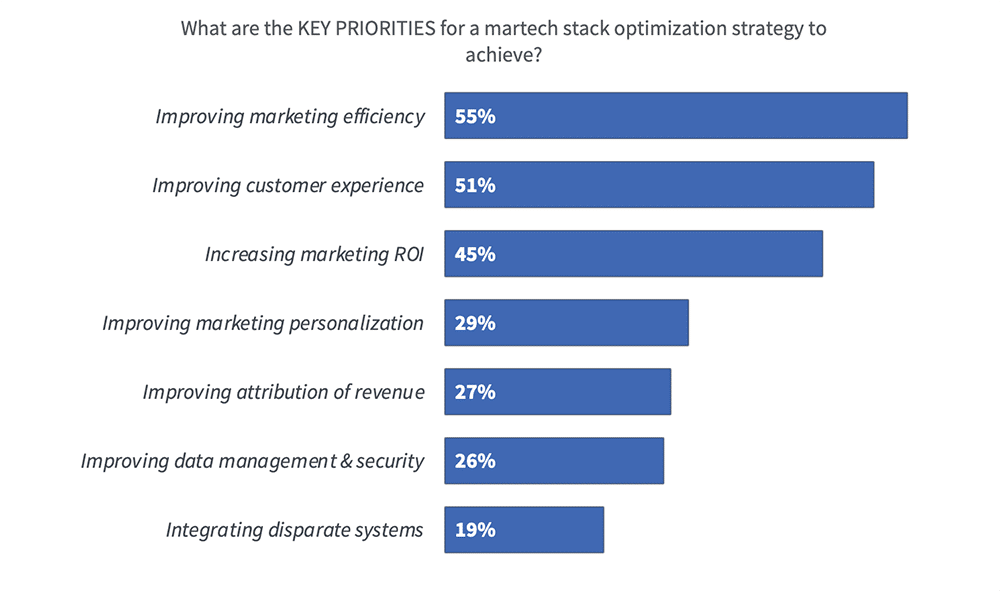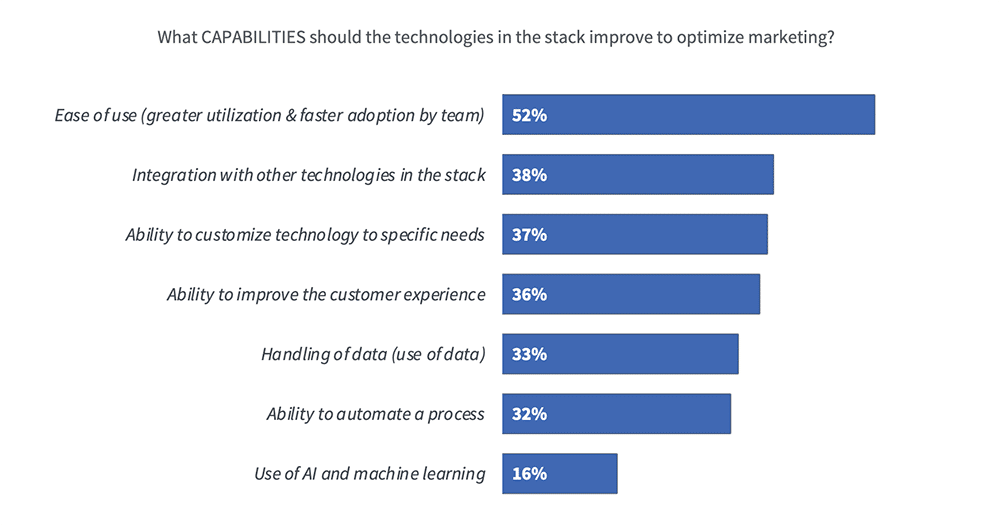
All too often we see marketing technologies become a junkyard of underutilized and disparate tools. So how do you know when it is time to check in and make sure each technology is enhancing your overall process?
Here are four research-backed signs that it is time to re-examine your MarTech stack to maximize efficiency, with insights from experts.
Sign #1: You aren’t seeing a return on investment.
According to our MarTech Stack Optimization survey, 45% of marketers say that increasing ROI is a top priority when optimizing their MarTech stack. It is critical to evaluate what you are getting out of your marketing tools, and if the associated cost is worth it.

“When choosing a new tool for our marketing stack, we consider the return on investment and how the tool will work for us in the long run. Some of the best marketing tools we started using three years ago are still in use today. For example, Intercom is amazing and we couldn’t manage without it. Every new tool we add to our marketing stack should have a great return on investment and the potential to be used for a longer time period – we don’t have time to test tools out and ditch them after a month.”
– Olga Mykhoparkina, CMO, Better Proposals | [Twitter]
Sign #2: You’re still completing tasks manually.
The purpose of introducing new technologies is largely to automate, streamlining marketing processes to make them more efficient.
When you find yourself manually completing tasks between tools, it likely means there is a gap that should be bridged. Ensuring the seamless integration of systems is considered a most important feature for 46% marketers as they implement marketing technologies.

“When building our MarTech stack, there are several things that we pay attention to, but one is more important than anything else – how well the new apps play with our existing app setup.
For example, we use GetResponse for email marketing and every new piece of software we get for lead generation needs to integrate with GetResponse. We need to be able to get new leads from that app into GetResponse quickly and accurately, without any loss of data. We know that Zapier exists as a solution, but we try to make our stack as lightweight as possible.
We want to automate every marketing process out there, which is why it’s crucial for us to have apps that integrate well with each other. For us, that’s an even more important consideration than how much the app costs.”
– Malte Scholz, CEO and Co-Founder, Airfocus | [LinkedIn] [Twitter]
Sign #3: You’re constantly battling to get your team to utilize tools.
Over half (52%) of marketers agree that technologies in your stack should improve ease of use. When a marketing technology is a pleasure to use, this results in faster adoption by the team. The more the tool is used, the more efficient it will be.

“Adding each new tool to the MarTech stack should be driven by the specific need to improve or optimize a specific marketing process. Once the need arises, we at iGMS are doing extensive research and comparing relevant solutions. We always consider the costs and the benefits while adding new tools to our marketing technology suite. After the most suitable option is selected, we put the tool to test. Luckily, almost every software solution on the market has a free trial. The most important step is to analyze the results that are delivered by the tool during the testing period. Always ask yourself: by how much it will speed up/optimize the processes and make the team tasks easier?
If the data can help you improve your marketing game, it could be worth adding to your MarTech stack.”
– Inna Shevchenko, CMO, iGMS | [LinkedIn] [Twitter]
Sign #4: You have overlapping technologies.
After an audit of your MarTech stack, do you have multiple technologies that all accomplish the same task? If so, this could be costing you money. Recognize where there is room to eliminate unnecessary tools and keep your MarTech stack as lean as possible.
“The primary consideration is whether the technology is necessary. Only add to your Martech stack if the tool will be useful. Not because the tech is the shiny new toy.
So, if you already have a CRM that sends mass emails and tracks engagement such as Agile CRM, then there is no need to purchase a dedicated email marketing software.”
– Reuben Yonatan, CEO, GetVoIP | [Twitter]
It seems that marketers have recognized, and are slowly taking action when it comes to addressing how marketing technologies are utilized and managed. Only about one-in-five marketing professionals (19%) have an operational strategy in place for optimizing a MarTech stack. However, another 58% report being in the development or implementation phase of optimization.
“When adding to your MarTech stack, it’s important to consider how the new technology plays with other existing tools and processes. If they work together and improves on existing processes, that’s an ideal fit. For example, we use visitor behavior data to move leads to different mailing lists. One tool that tracks user behavior enables the other which handles segmentations and lists.”
– Andrus Purde, CEO, Outfunnel | [LinkedIn] [Twitter]
When it comes time to audit your MarTech stack, check out our free report, MarTech Stack Optimization. We surveyed hundreds of marketers to discover strategies, tactics and trends for optimizing a MarTech stack.
For the entire MarTech Stack Optimization report, click here.
What’s inside:
- Current Situation
- Challenging Barriers
- Key Priorities
- Strategic Success
- Priorities Versus Barriers
- Capabilities Improved
- Important Features
- MarTech Stack Investment
- Resource Allocation
Use it to gain insight on what other marketers are doing to better their email strategy, or clip the charts for your own content marketing!
Be sure to visit our Research Library for free reports on a wide variety of the most popular digital marketing topics.

